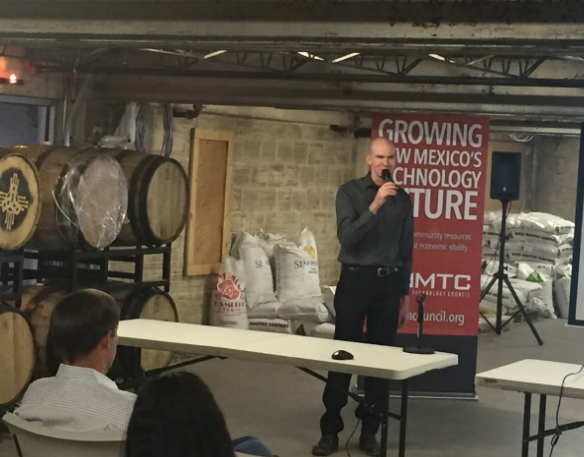Breweries aren’t just places to get a drink. At Albuquerque’s Tech on Tap events, entrepreneurs use local breweries as places to share business ideas.
Tech on Tap is an ongoing event curated by The New Mexico Tech Council where business and tech leaders meet and discuss innovative business ideas.
In March, Rio Bravo Brewing Company hosted some 15 locals who were served beer and wine while Stephen Myers, the product manager and research scientist at Skinfrared LLC, discussed infrared technology.
“The first question is ‘what is infrared radiation,’” Meyers said. “The question is the same as ‘What is a color?’”
Meyers said infrared technology is used to measure infrared energy, a type of electromagnetic energy with wavelengths too long for human eyes to see (whereas color is in the visible range). When one is measuring heat or temperature, they’re usually measuring infrared energy. Basically, infrared technology measures the temperature of objects by measuring the amount of infrared energy coming off of them.
Skinfrared LLC is in the expanding field of custom-fabricated long-wave infrared (LWIR) detector devices.
At the event, sponsored by many organizations, including PNM, ABQid, and Los Alamos National Laboratory, Meyers displayed a number of tools and devices that utilize infrared technology.
One of the objects Meyers showcased was a remote control. He clicked a small button on the remote, and, seemingly, nothing happened. But when audience members looked at the remote through a smartphone camera, that button had caused a small light to flash on the remote. The phone had an infrared camera that could see the pulsing infrared energy, which was invisible to the naked eye.
“It’s small and cheap,” Meyer said of the camera. “They have started to make devices you can actually attach to your smartphone or tablet”
Another gadget Meyer demonstrated for his audience of fellow entrepreneurs was a thermal camera. Using the camera, Meyer could take a picture of a hand or a tablet PC and see the temperature of the objects.
Many audience members were interested in trying the device. They passed it around and took infrared photos.
Doug Rietz, the manager of business development at Rural Sourcing INC, a company that provides IT services to a number of organizations, said his favorite part of the night was playing with the thermal camera.
“I like learning about the light” he said. He also said he was enjoying the “Tech on Tap” series, which he attends to support its sponsor, the New Mexico Technology Council.
NMTC is an association of businesses, organizations and tech professionals working together to promote the growth and success of New Mexico’s technology business sectors.
Audience member Leslie Fraser of Santa Fe, who is a fundraiser and education art specialist, said she attended the event to help improve her teaching.
“When I develop programing for kids, it combines science and art design programing which we call STEAM,” she said, making the case for more research to build curriculum around infrared technology.
History of infrared technology
Infrared detection and imaging has a long history of development and the technology is being pushed into range of applications from military and defense to medical and industrial diagnostics.
Meyer said a tremendous amount of work in the field is being conducted at research universities. A goal of Albuquerque-based Skinfared is to help transfer the technology developed in the university setting to the marketplace. The company aims to develop a low cost, portable, high performance, infrared imaging system for military and commercial application.
“It is definitely growing,” Meyer said. “For instance, I showed this little device, the thermal camera, on here just few years ago. Maybe two or three years ago, something likes this cost a few thousand dollars. Now, it costs a couple of hundreds dollars. It is going to get cheaper.”
